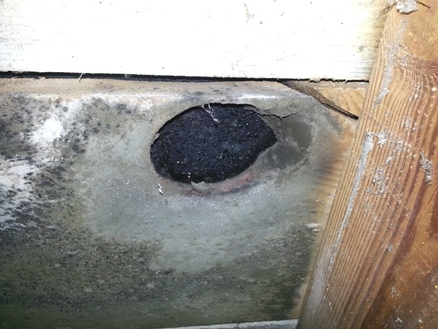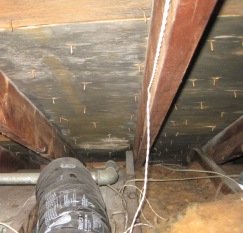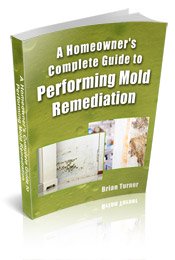Find a Mold Specialist Now
Click or Call, Toll-Free 24/7
Mold in Attic
Mold in attic is fairly common, because attics are often damp. If your roof leaks or any attic windows leak, you’ve got moisture in your attic and probably need to consider attic mold removal. Even if your roof and windows don’t leak, though, humidity in the attic can lead to the growth of mold.
Picture of Mold in the Attic
If you’re not sure what you’re looking for, here’s a picture of mold in an attic. It usually appears greenish-black and streaky. However, there are many different types of mold, so if the mold in your attic looks different, that does not mean you don’t have a problem or don’t need to worry about it or take action. Nearly all types of mold can cause health problems, so if there is mold in your attic, you need to get rid of it.
Need for Attic Mold Removal
Removing attic mold can be costly, time consuming and troublesome and since it’s in the attic where few people will see it, you might be tempted to just leave it alone. Don’t. It will spread. It won’t stay confined in the attic but will eventually spread to other areas of your home. It’s unsightly, causes an unpleasant musty odor, and can also lead to a wide range of health problems.
Health Problems Associated with Mold in the Home
Health problems associated with mold in the home, including mold in attic, are wide ranging and include things like difficulty breathing, asthma attacks, the development of asthma in people previously unaffected by the disease, upper respiratory infections, sinus infections, headaches, sore throats, fatigue and allergy symptoms. Spores from mold in attic can spread throughout your house so you and your family can be affected even if you don’t spend much time in the attic.
Attic Mold Removal Process

Some people prefer to try to clean up attic mold on their own, while others prefer to call in a mold removal specialist. Most specialists will conduct a free inspection and offer free advice about dealing with your mold problem. In many cases, home owner’s insurance will even cover the cost of attic mold removal. We really recommend letting a professional do the job since it’s so important to get it done right.
The mold removal process involves scrubbing hard surfaces with a biocide, but porous items like insulation and drywall cannot be cleaned and must be thrown out and replaced. Wooden wall studs and similar items must often be sanded to remove all traces of mold, since wood is somewhat porous. However, sanding can expose you to dangerous amounts of mold and should only be done by a trained professional.
You need protective gear when treating your attic for mold, including rubber gloves, goggles and a face mask. Launder all clothing immediately after a cleanup session so you don’t track mold spores into the rest of your house. You should also hang sheets of plastic in front of the attic door, using duct tape to secure the edges, in order to prevent mold spores from drifting out into the rest of the house once your cleanup efforts disturb them. Any hi-hats or vents should also be covered with plastic and taped securely. Insulation or other substances that are contaminated with mold can be sealed in plastic bags and thrown out a window so that mold spores aren’t tracked through your house, creating new problem areas. Any duct work in the attic may need to be replaced. Mold removal specialists will bring their own supplies, of course, but if you do decide to tackle the job yourself, you can find what you need at most home improvement or hardware stores.
It is recommended to use a negative air machine during the remediation process. This way if any mold spores become airborne, they will be pulled out of the house before they have a chance to travel anywhere else in your home. Remember, leave just a little mold behind and it may quickly grow back.
We Recommend Consulting with a Mold Removal Specialist if You Have Mold in Attic
If you have mold in the attic, we recommend consulting with a mold removal specialist because:
- Insulation is often affected.
- Wooden beams and plywood may be affected and it can be difficult to remove all traces of mold from wooden surfaces.
- Heating, ventilation, and air conditioning ducts may also be affected.
- Mold removal specialists will have all the necessary equipment to do the job properly, including a negative air machine.
- Mold removal specialists know how to do the job safely, without exposing you and your family to additional mold spores that may be hazardous to your health.
- Most mold removal specialists offer free consultations, during which you can gather important information and advice even if you opt to handle the mold removal yourself.
Follow this link for a list of mold removal specialists offering free consultations in your area.
Return From Mold In Attic To Our Black Mold Health Symptoms Home Page






